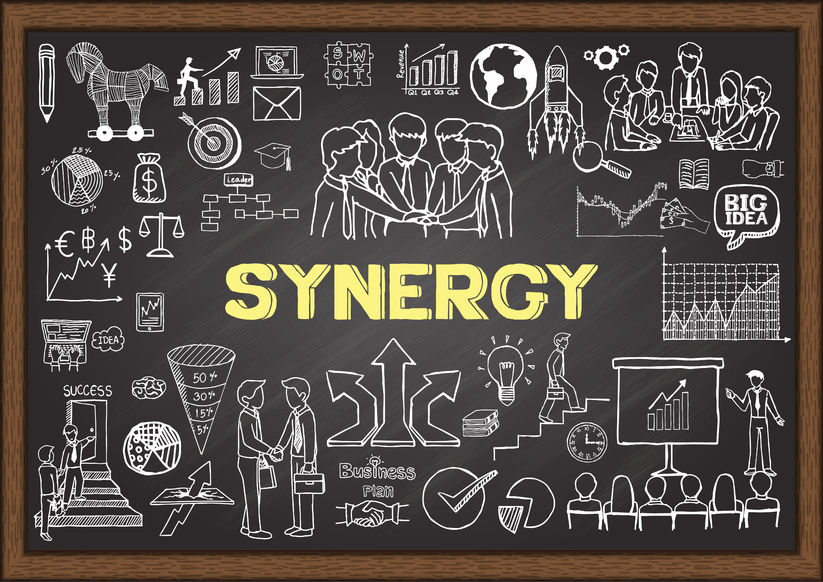The development of any sphere of life, and above all the business sphere, depends on what effect the correct combination of several ideas oriented towards one goal will have. To put it simply, several complementary projects will yield results that exceed the development results of a single idea. Synergy in business is a determining factor in the stability and development of small companies.

What is Synergy?
Scientifically speaking, synergy is the need for two or more forces (things, matter, etc.) to cooperate in an effort to achieve a certain mutually beneficial effect. We can enumerate the essence and reflection of this term to infinity, but, putting all the examples in one definition we will say that synergy is the effective interaction of several forces to create one more stable and powerful flow.
The synergistic effect is defined by what exactly the output will be when several components are combined and interact. In the definition, it is important to consider the factor that such terminology is not only applicable if there is a positive end result. A negative outcome will also be the result that is achieved when a pattern of interaction is utilized.
Types of Synergy
In finance, there are typically two main types of synergy: operational synergy and financial synergy.
Operational Synergy
When multiple companies join or work together, it leads to better production and efficiency, which is known as operational synergy. Numerous factors, including economies of scale, streamlined procedures, and shared resources, might give rise to it. For instance, when two banks join, they can eliminate unnecessary administrative tasks and branches, saving money.
Financial Synergy
On the other hand, financial synergy emphasizes the influence of pooled financial resources and plans. Better capital allocation, lower borrowing costs, and increased financial stability can result from this kind of synergy. In the event of a merger, the newly created firm can have access to a bigger financial source, allowing it to make more risky investments or initiatives.
Applications of Synergy Models in Finance
Mergers and Acquisitions
The setting of mergers and acquisitions (M&A) is one of the most popular uses of synergy models in finance. Companies frequently pursue M&A transactions in the hope that integrating their operations will have beneficial synergies. Cost savings, higher market share, and a wider range of products are some of these advantages.
Cost Synergy
One of the main forces behind many M&A deals is cost synergies. Companies can dramatically lower their costs by streamlining supply chains, removing duplication from processes, and combining activities. This synergy frequently entails workforce rationalization, which entails the elimination of unnecessary employees, but it can also include cost savings in areas like marketing, procurement, and other areas.
Revenue Synergy
Another key component of M&A negotiations is revenue synergies. When the united company can make more money than the individual businesses could independently, it happens. This might happen as a result of reaching out to new markets or cross-selling goods and services to a larger clientele.
Risk Diversification
Diversification of risk can result from mergers as well. The newly formed firm may obtain a more balanced and resilient risk profile by combining two companies with distinct risk profiles or geographic exposure. This may be especially crucial in sectors of the economy that are vulnerable to external shocks or economic cycles.
Strategic Partnerships
Synergy models are important in strategic alliances as well as merger and acquisition (M&A) transactions. To capitalize on one another’s advantages and accomplish shared objectives, businesses frequently form alliances or joint ventures. These collaborations can increase company competitiveness and open up new possibilities.
Technology Collaborations
Synergy models are common in the technology industry. Tech businesses routinely work together to create cutting-edge goods or services, split R&D expenditures, and gain access to one another’s consumer bases. These collaborations can shorten the time to market and speed up product development.
Cross-Industry Alliances
As businesses look to expand into new markets and client groups, cross-industry collaborations are becoming more and more prevalent. For instance, a pharmaceutical company and a technology company might collaborate to create healthcare solutions that combine cutting-edge medical technology with data analytics.
Measuring Synergy in Finance
Quantifying Synergy
Financial transaction synergy measurement is a difficult and frequently arbitrary process. To calculate the value of synergy, financial analysts employ a variety of techniques, such as:

- Discounted Cash Flow (DCF) Analysis: DCF analysis entails estimating and discounting to present value the merged entity’s future cash flows. The estimated value of synergy is the difference between the present value with synergy and the sum of the present values without synergy.
- Market Valuation: Analysts may also employ market-based strategies, comparing the combined entity’s post-transaction market worth to the total of the individual companies’ pre-transaction market valuations.
- Earnings Before Interest and Taxes (EBIT) Multiples: Estimating the possible increase in profitability brought on by synergy can be done with the aid of EBIT multiples. To assess the effect of synergy, analysts compare the post-transaction EBIT multiples to the pre-transaction multiples.
Challenges in Synergy Measurement
Synergy measurement is not without challenges. Making assumptions about future cash flows, market conditions, and the success of integration efforts is a common part of this process. Additionally, due to unforeseen challenges or modifications in the business environment, the actual realization of synergy may vary from earlier forecasts.
Synergy Models and the Economy
Economic Impact
The use of synergy models in finance has an effect on the economy as a whole, not only on specific businesses. Synergistic mergers and collaborations enable organizations to generate cost savings and operational improvements, which frequently trickle down to customers in the form of reduced pricing or higher-quality goods and services.
Job Creation and Displacement
In some sectors of the business, mergers and acquisitions might result in job growth while eliminating jobs in other areas. For instance, the consolidation of back-office activities may result in administrative job cuts, while job growth in the sales and marketing divisions may be possible as the company widens its market.
Competition and Innovation
Additionally, synergy models might affect market rivalry and innovation. While mergers might improve a company’s ability to compete, they can also lower the number of competitors in a market, which could result in less competition. Synergy results in increased financial resources, but these resources can also spur innovation and the creation of new goods and services.
Risks and Challenges in Synergy Models
Integration Risks
The integration of the merging entities is crucial for the successful realization of synergy. Integration procedures can be difficult, time-consuming, and complex. The obstacles that can prevent the implementation of synergies include cultural differences, incompatible IT systems, and employee opposition.
Overestimation
One of the most significant risks in synergy models is the potential for overestimating the benefits. Optimistic assumptions about cost savings or revenue growth can lead to disappointment if the expected synergy does not materialize as anticipated. This can result in financial underperformance and shareholder dissatisfaction.
Regulatory and Legal Hurdles
Regulations frequently scrutinize mergers and partnerships, which can cause delays or even the transaction’s termination. Synergy models may face considerable difficulties as a result of antitrust issues, national security concerns, and other regulatory barriers, thus it is crucial for businesses to successfully overcome these constraints.
Case Studies
To illustrate the practical application of synergy models in finance, let’s examine two notable case studies:
The Disney-Fox Merger
The Walt Disney Company finished acquiring 21st Century Fox in 2019. This merger aims to bring together Fox’s film and television assets with Disney’s content creation and distribution capabilities. For its streaming services, including Disney+, Disney anticipated considerable cost reductions, revenue growth, and an expanded content library.
The Pfizer-Wyeth Merger
Pharmaceutical behemoth Pfizer purchased Wyeth in a historic merger in 2009. The cost savings from the elimination of duplicative research and development efforts as well as higher income from Wyeth’s medicine portfolio were part of the synergy models that underpinned this agreement. Pfizer was able to improve its standing in the pharmaceutical sector thanks to this combination.
For companies looking to uncover hidden value and accomplish strategic objectives, synergy models in finance have evolved into crucial instruments. Companies can use synergy to increase productivity, save costs, and spur growth through mergers, partnerships, and other cooperative ventures. However, achieving these advantages calls for thorough preparation, meticulous implementation, and a deep understanding of the risks and difficulties present. Synergy models will continue to play a crucial role in determining the future of firms and the overall economy as the financial landscape changes.